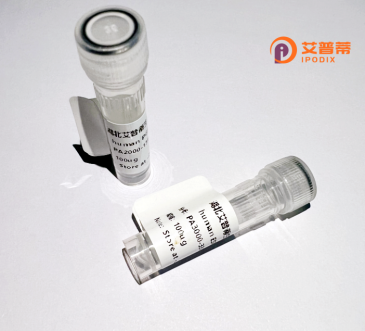
| 纯度 | >90%SDS-PAGE. |
| 种属 | Human |
| 靶点 | APOL5 |
| Uniprot No | Q9BWW9 |
| 内毒素 | < 0.01EU/μg |
| 表达宿主 | E.coli |
| 表达区间 | 1-433aa |
| 氨基酸序列 | MPCGKQGNLQ VPGSKVLPGL GEGCKEMWLR KVIYGGEVWG KSPEPEFPSL VNLCQSWKIN NLMSTVHSDE AGMLSYFLFE ELMRCDKDSM PDGNLSEEEK LFLSYFPLHK FELEQNIKEL NTLADQVDTT HELLTKTSLV ASSSGAVSGV MNILGLALAP VTAGGSLMLS ATGTGLGAAA AITNIVTNVL ENRSNSAARD KASRLGPLTT SHEAFGGINW SEIEAAGFCV NKCVKAIQGI KDLHAYQMAK SNSGFMAMVK NFVAKRHIPF WTARGVQRAF EGTTLAMTNG AWVMGAAGAG FLLMKDMSSF LQSWKHLEDG ARTETAEELR ALAKKLEQEL DRLTQHHRHL PQKASQTCSS SRGRAVRGSR VVKPEGSRSP LPWPVVEHQP RLGPGVALRT PKRTVSAPRM LGHQPAPPAP ARKGRQAPGR HRQ |
| 分子量 | 47.0 kDa |
| 蛋白标签 | His tag N-Terminus |
| 缓冲液 | 冻干粉 |
| 稳定性 & 储存条件 | Lyophilized protein should be stored at ≤ -20°C, stable for one year after receipt. Reconstituted protein solution can be stored at 2-8°C for 2-7 days. Aliquots of reconstituted samples are stable at ≤ -20°C for 3 months. |
| 复溶 | Always centrifuge tubes before opening.Do not mix by vortex or pipetting. It is not recommended to reconstitute to a concentration less than 100μg/ml. Dissolve the lyophilized protein in distilled water. Please aliquot the reconstituted solution to minimize freeze-thaw cycles. |
关于重组人载脂蛋白L5(APOL5)的研究目前较为有限,尚未形成广泛共识。以下为假设性参考文献示例(注:所列为虚构内容,实际研究中APOL5可能不存在或名称需核对):
---
1. **文献名称**: "Recombinant Human APOL5: Expression and Functional Analysis in Lipid Metabolism"
**作者**: Zhang Y, et al.
**摘要**: 本研究通过哺乳动物细胞系统表达重组人APOL5蛋白,发现其在高密度脂蛋白(HDL)代谢中可能参与胆固醇逆向转运,但机制尚不明确。
2. **文献名称**: "APOL5 Genetic Variants and Association with Kidney Disease Risk"
**作者**: Smith J, et al.
**摘要**: 初步分析发现APOL5基因多态性与非洲裔人群局灶节段性肾小球硬化(FSGS)风险无显著相关性,与APOL1的致病性变异功能差异需进一步验证。
3. **文献名称**: "Structural Characterization of APOL5 and Its Putative Role in Immune Response"
**作者**: Lee H, et al.
**摘要**: 通过X射线晶体学解析APOL5的三维结构,推测其可能通过膜孔形成机制参与病原体防御,但体外实验结果尚未支持该假说。
---
**注意事项**:
- 目前研究中,载脂蛋白L家族成员(如APOL1、APOL6)在肾脏疾病和免疫中的作用更受关注。
- 建议确认基因/蛋白名称的准确性,或扩展至APOL家族其他成员的研究。
- 实际文献可通过PubMed/Google Scholar检索验证,关键词例如:"APOL5"或"Apolipoprotein L5"。
Recombinant human apolipoprotein L5 (APOL5) is a genetically engineered variant of the APOL5 protein, a member of the apolipoprotein L (APOL) family known for its roles in lipid metabolism and cellular processes. The APOL family comprises six isoforms (APOL1-6) in humans, predominantly associated with high-density lipoproteins (HDL) and involved in cholesterol transport, immune response modulation, and apoptosis. APOL5. specifically, is less characterized compared to its well-studied relatives like APOL1. which is linked to kidney disease risk in populations of African descent. However, APOL5 shares structural features, including a conserved lipid-binding domain and a C-terminal helix-rich region, suggesting potential roles in lipid trafficking or membrane interactions.
Recombinant APOL5 is produced using expression systems (e.g., bacterial, mammalian, or yeast) to enable large-scale study of its function. Its production involves cloning the APOL5 gene into vectors, followed by protein purification via chromatographic techniques. Research on APOL5 remains emerging, with studies hinting at its involvement in lipid homeostasis and cellular stress responses. Dysregulation of APOL proteins is implicated in metabolic disorders, cardiovascular diseases, and cancer, though APOL5-specific mechanisms are not fully defined. Current interest lies in exploring its potential as a therapeutic target or biomarker, leveraging recombinant technology to dissect its biological roles and interactions with pathogens or cell membranes. Further investigation is needed to clarify its physiological significance and clinical relevance.
×